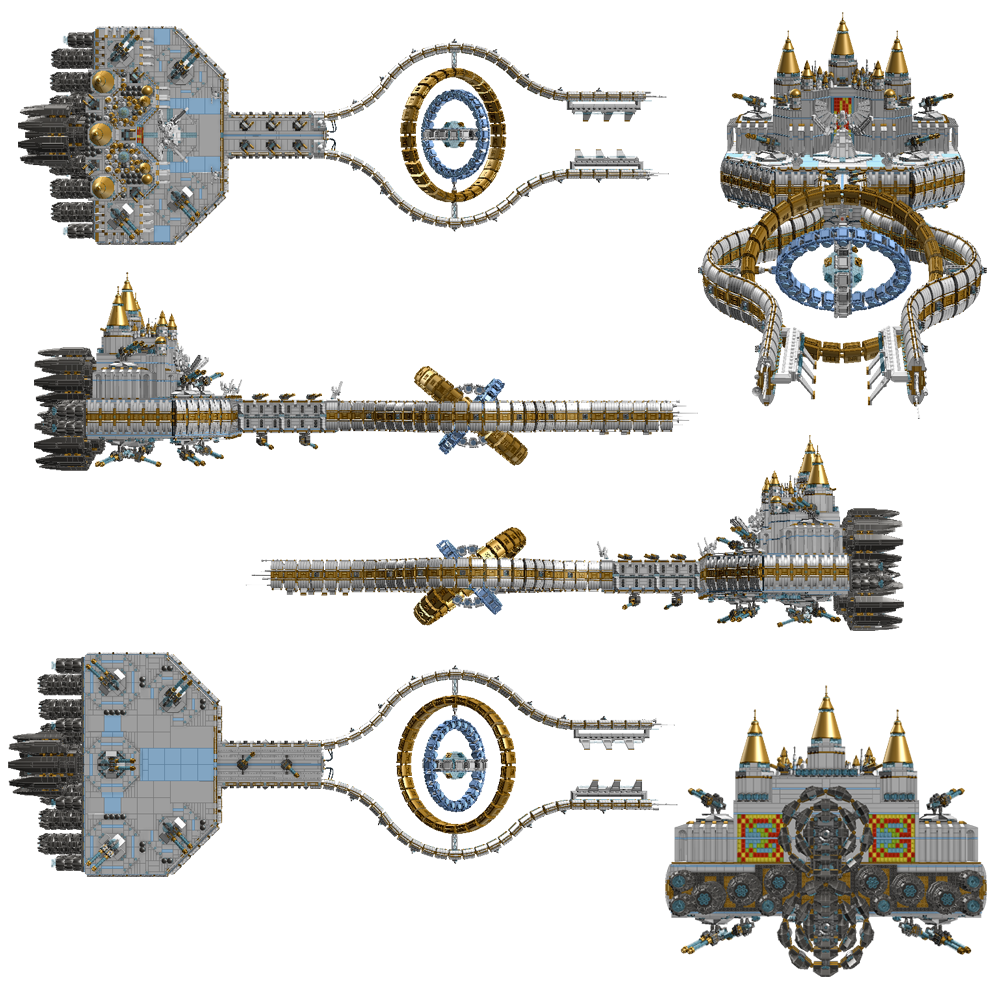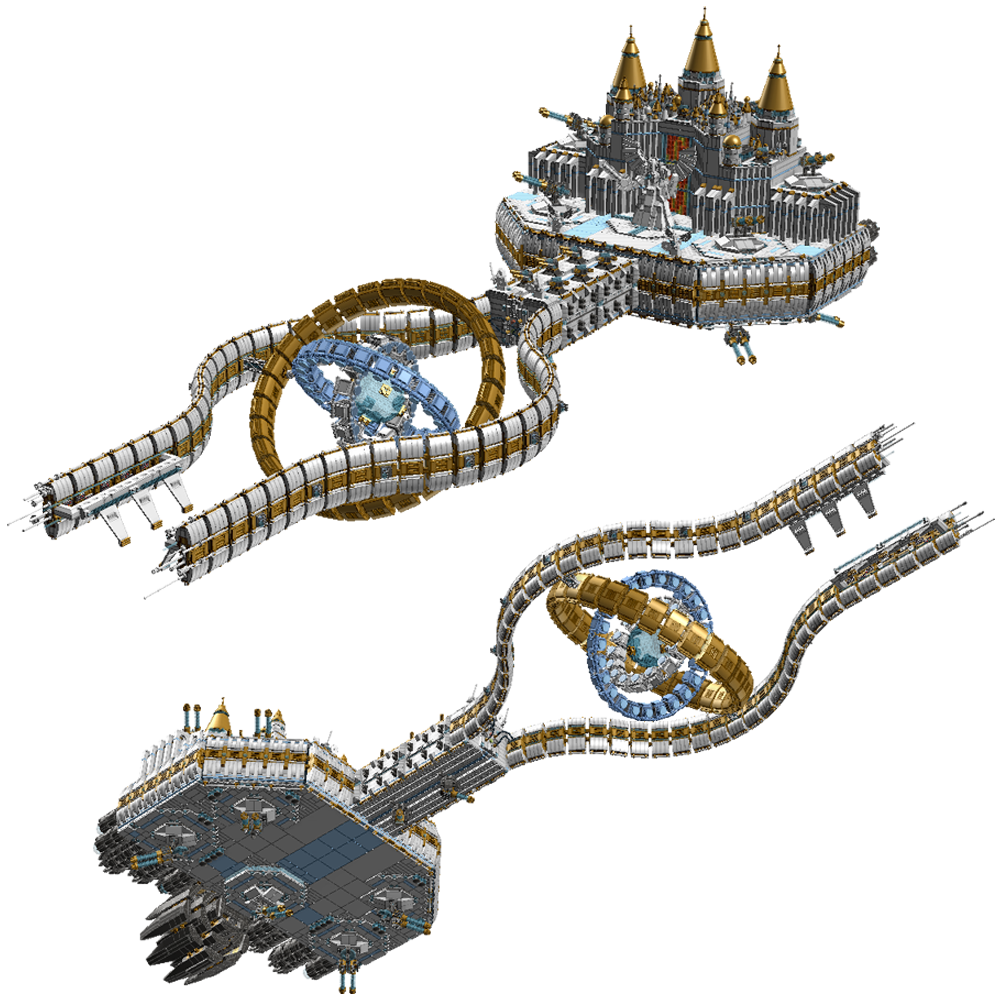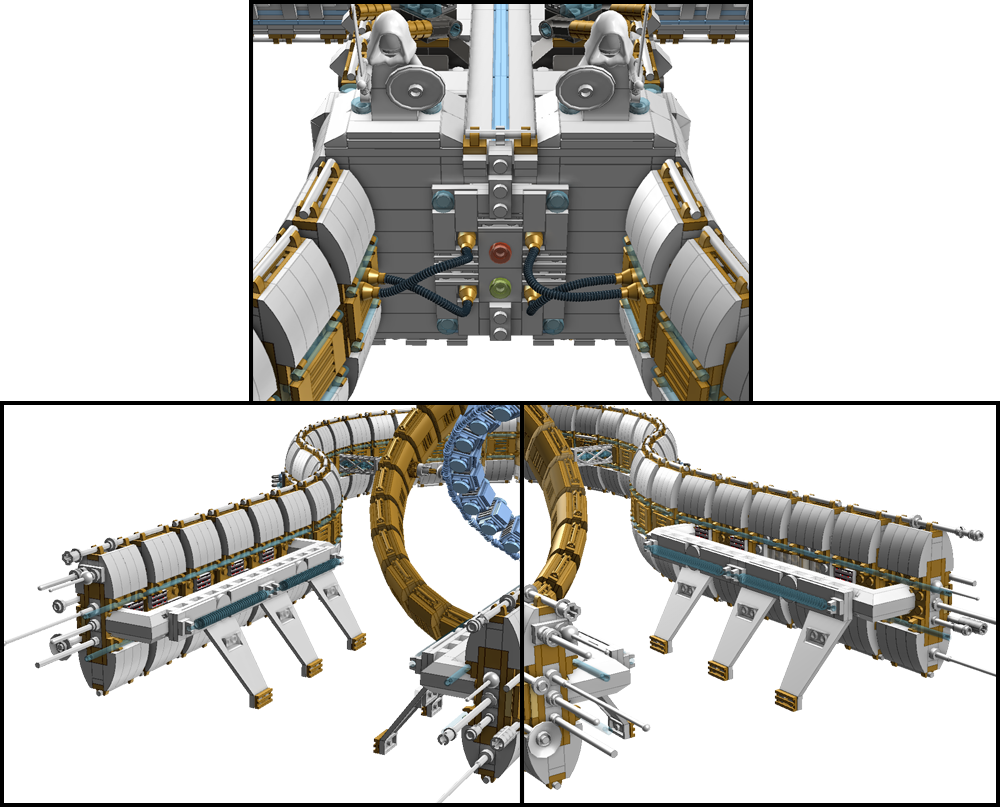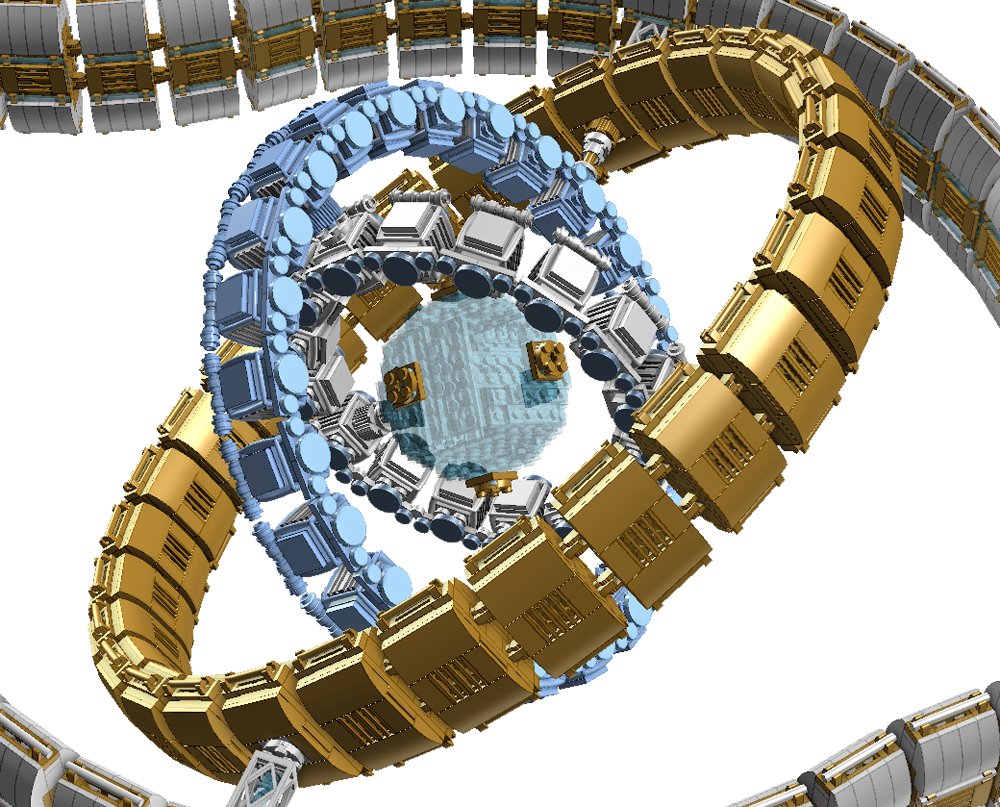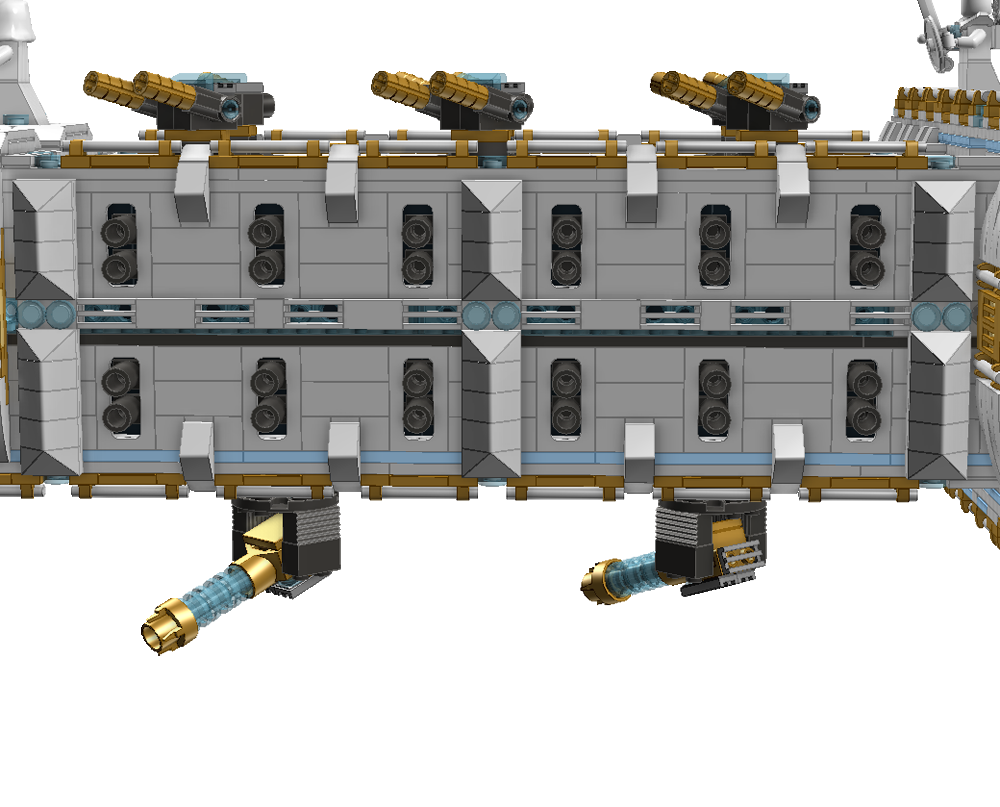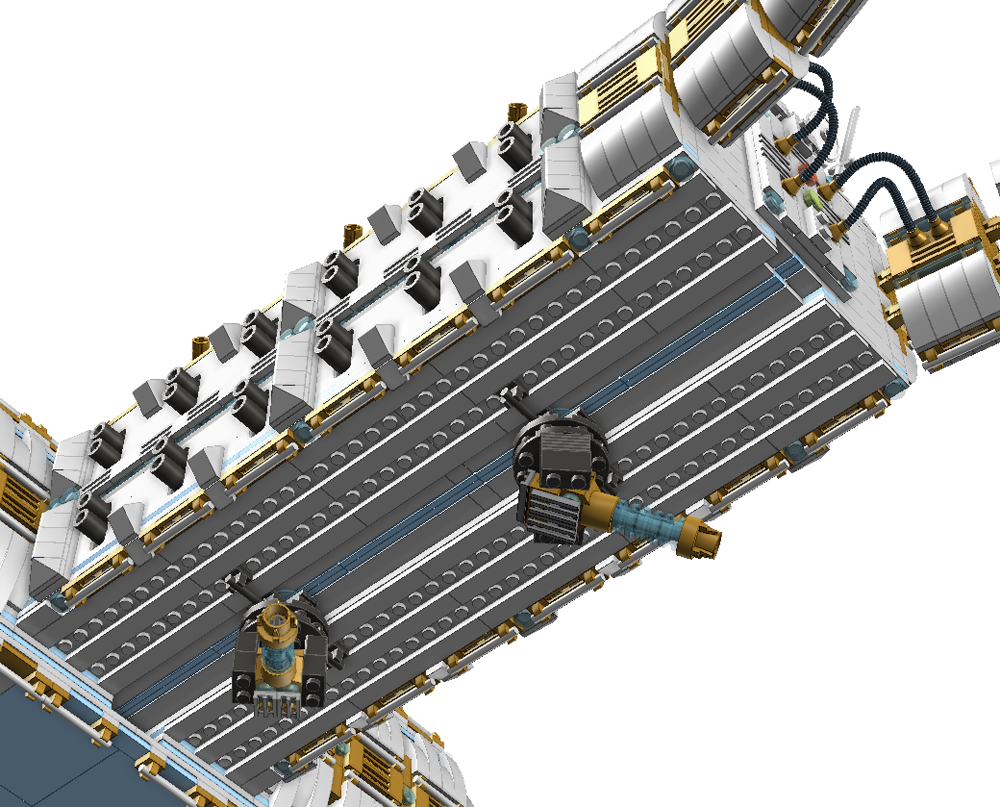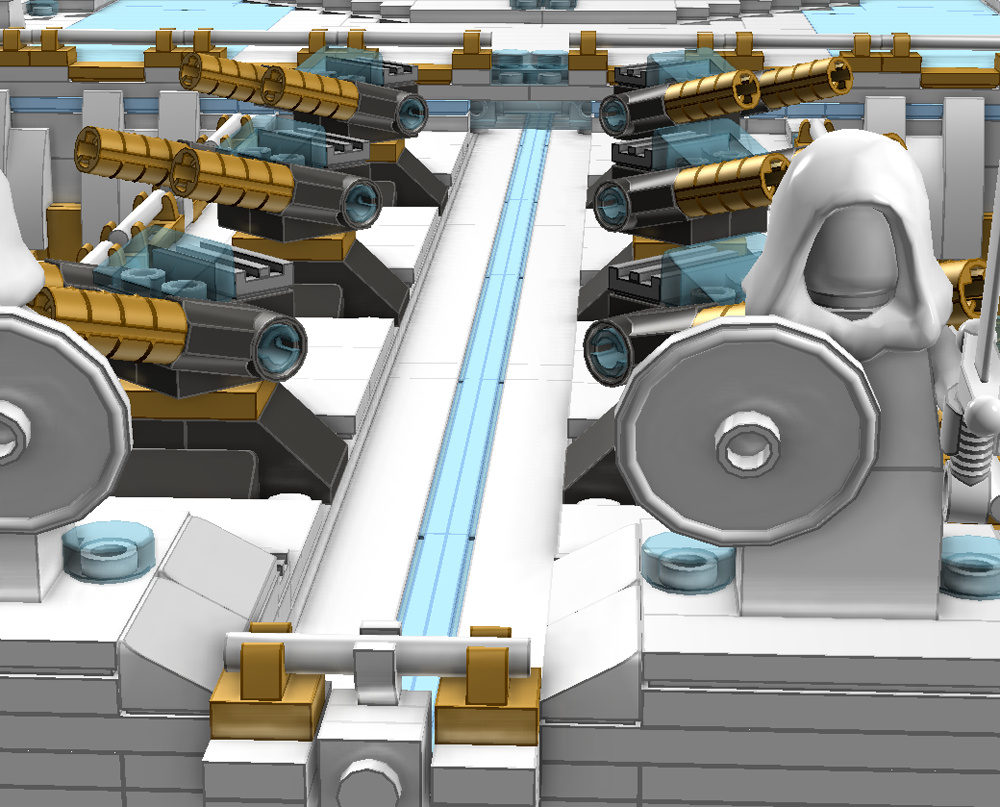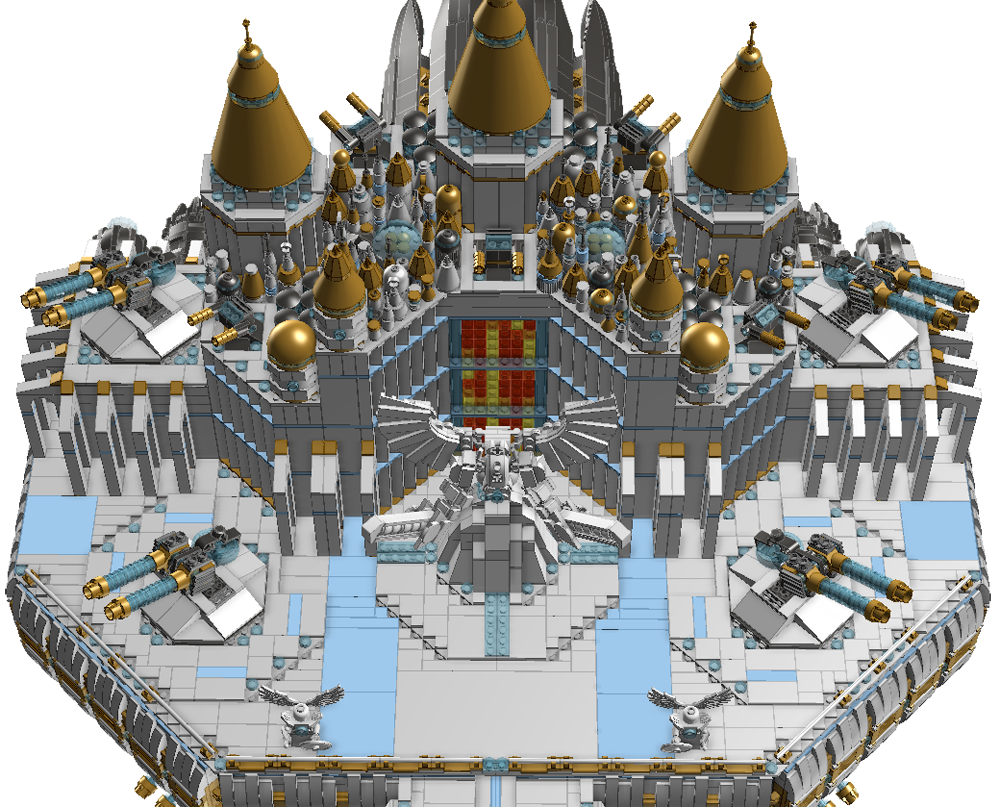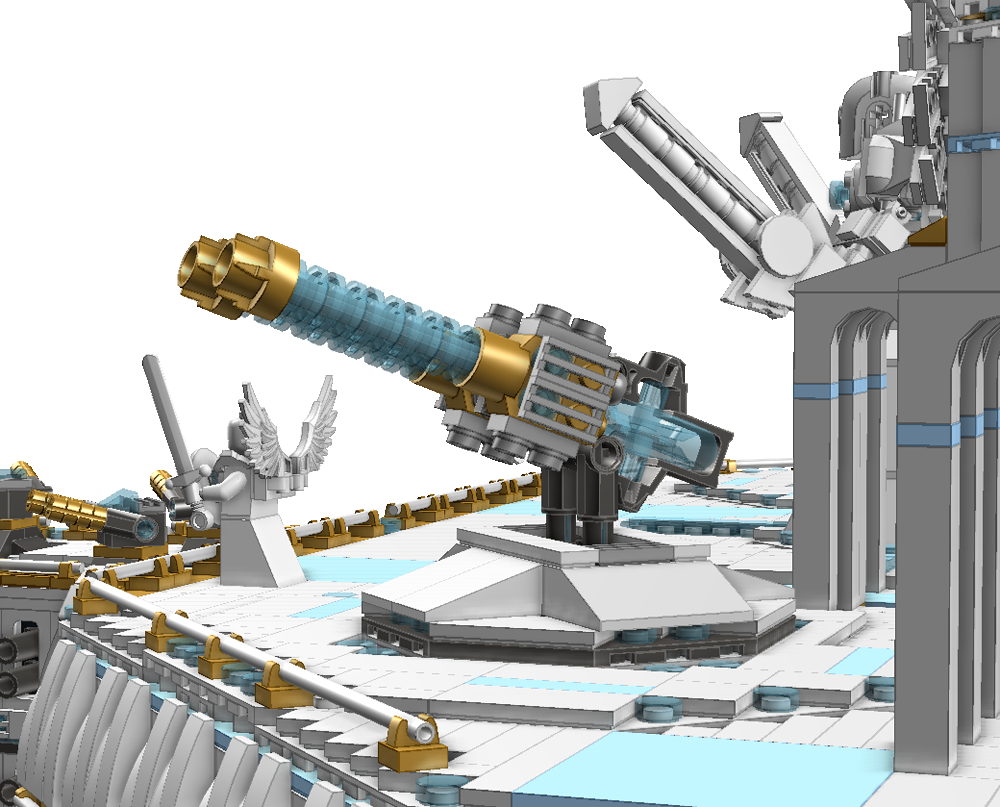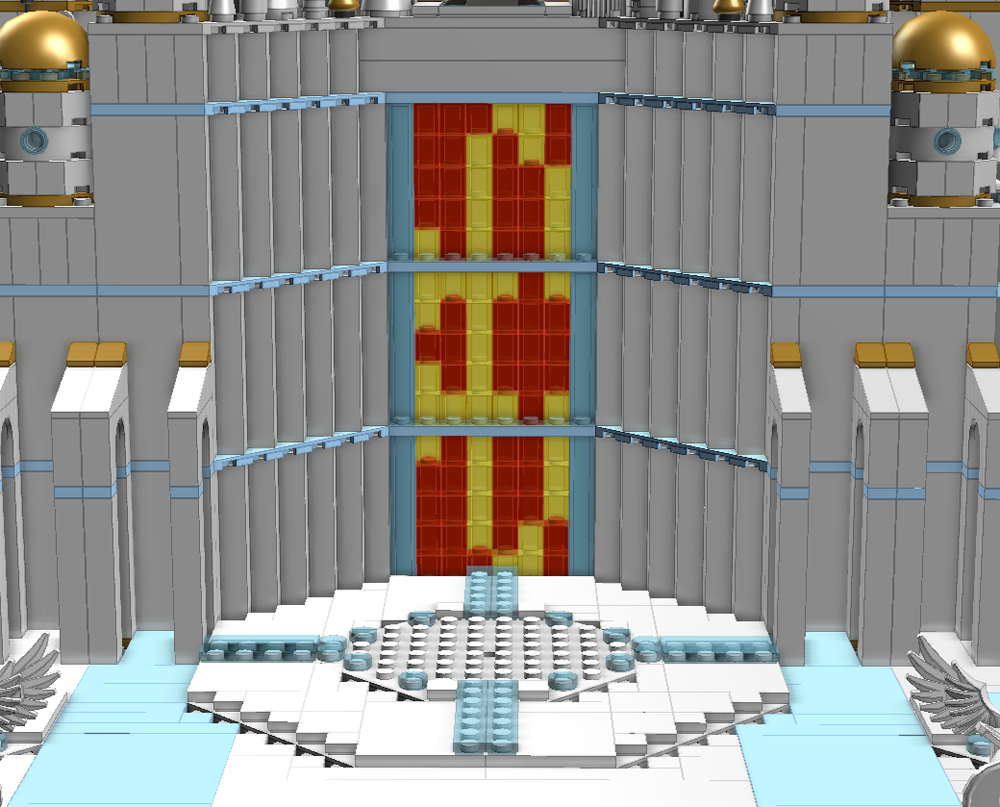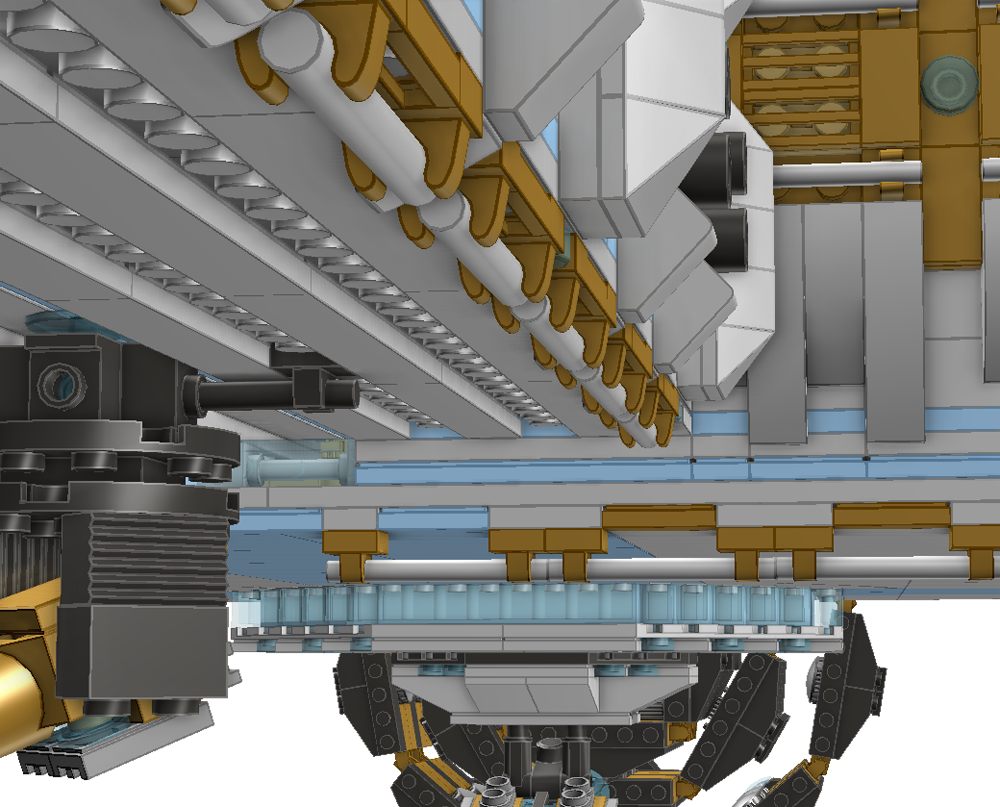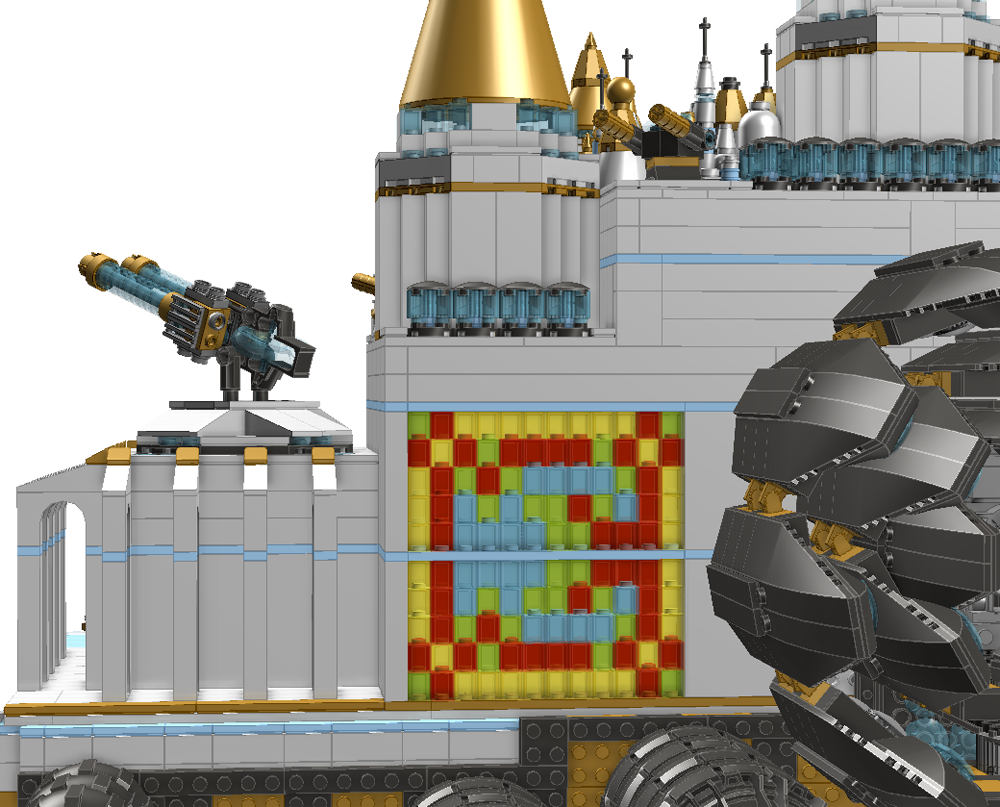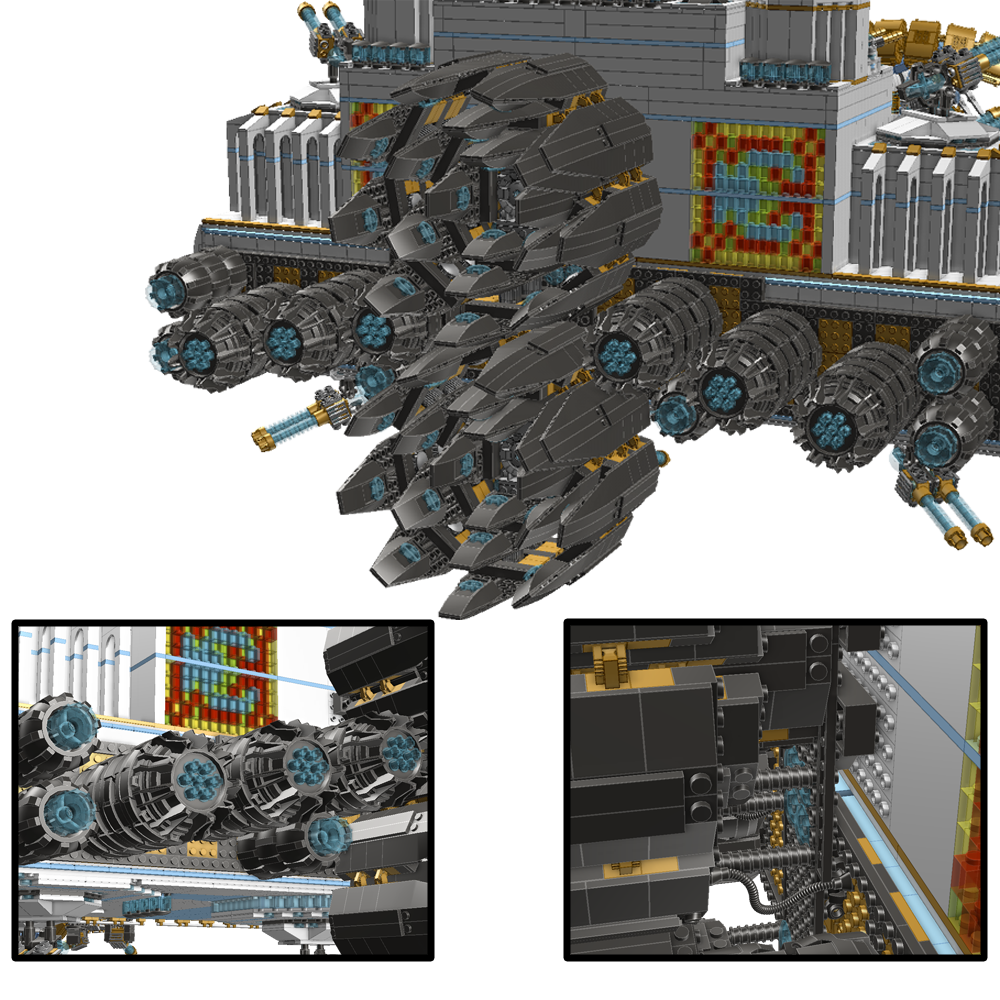Lux Araphelinus Dreadnaught
Araphelinus Type Dreadnaught Overview
Scale: Micro
Size (longest dimensions):
- Length: Approx. 245 Studs (Approx. 6.43ft. or 1.96m)
- Width: Approx. 85 Studs (Approx. 2.23ft. or 0.68m)
- Height: Approx. 60 Bricks (Approx. 1.89ft. or 0.58m)
Part Count: 15152 Bricks, 46 Nonessential
Araphelinus Type Dreadnaught Multiview 2
The Lux Araphelinus Dreadnaught is among the oldest of Lux starship designs. Throughout the eons, the design has changed only somewhat: a multipurpose and extremely large vessel comprised of a solid mixture of soft and hard style architectural aesthetics. Shown here is a more classical style Araphelinus. Its colossal cathedral like main body typically houses a major Lux city. The Lux do not have a homeworld of their own as they are extraplanar in origin, hailing from the divine realm of BrikHeaven. It is unknown, thanks to the mental memory erasing barrier that exists between that plane of existence and this one, whether they have established geographical and political communities there. It’s probably safe to assume that they do. The main body is attached to a Gun Bridge, laden with weaponry. This, in turn, is attached to twin prongs that bow outward near their center length to form a center ring which cocoons a massive gyrostabilizer device. This device seats a WarSpirit of some description, who powers the entire vessel and its subsystems, whether propulsion and navigation, sensors and communication, or weaponry and animation nodes. The Araphelinus embodies a chariot like design, with the WarSpirit almost pulling the rest of the vessel along, though it does utilize the virtually redundant engine array at the rear of the ship to assist in this endeavor.
Prong Couplings, Port Prong, and Starboard Prong
The twin prongs are detachable in case of WarSpirit destruction. The prongs themselves are rather solidly connected and, despite appearances, the separation mechanics are completely internalized. The gun bridge does have massive multideck airlocks located at either of its ends and many a rare enemy that have seen this vessel type’s true form have fallen prey to the mistake of firing on the heavily armored airlock or the adjacent connection points.
Both the port and starboard prongs have similar features, aside from the long viewport on the starboard side. Both maintain a redundant long range communications array. There are more redundancies within the Lux City, Gun Bridge, and Central Command. All of which are keyed to the WarSpirit but can also operate independently should the need arise. Both prongs also maintain one half of an energy capture and hyper focusing device called a Consecration Cannon. One might think of this deadly device as the ship’s main gun. Simply, the WarSpirit sends a massive burst of energy toward the front of the ship, the CC harnesses the energy, focuses and refines it, then fires it off in an absolutely devastating blast of holy fire called Purefire. The CC can also collect background radiation and other types of energy for conversion into usable Purefire. This makes a forward assault on the Araphelinus nothing short of foolhardy, as the CC device is more than capable of capturing almost any weapons fire, converting it to Purefire, and returning the attack with perhaps more force than that with which it was made.
Internal Power Flows and External Gunnery Stations
The inside wall of the prongs shows the outermost layer of redundant power flow systems. These flows carry the WarSpirit’s energy, or stored Purefire or conventional energies in the absence of a spirit, throughout the ship. As we can see here, everywhere on the ship that is lit up with blue transparent denotes either a power flow or its terminus.
The outside wall is more heavily armored and, dotted along its length, are multiple gunnery stations. These stations are each typically manned by a large team of gunners to reduce strain on the WarSpirit or central computer systems. They have a limited arc of fire and consist of three linked long cannons. These cannons are equipped to process and fire Purefire if need be but aren’t designed to handle energy of that magnitude for very long. They will burn out after a handful of volleys and will need to be replaced completely. Most station leaders will only use this tactic in a desperate situation. In the meantime, the guns are perfectly capable of firing high intensity, medium range laser beams all day long.
WarSpirit with GyroStabilizers
As WarSpirits age and grow in power, they gain a greater and greater fundamental understanding of the underpinnings of the universe. They “see” omnidirectionally, the very fabric of reality revealing itself to them and forming a mental landscape of everything within a truly vast distance. The distance and scope of this ability is phenomenal even for relatively young spirits. All but the most clever stealth systems are useless against them and their communication range is astronomical. They learn to calculate with increasing precision and to truly multitask. As they develop this hyper intellect, and physically grow and change in form, however, they become decidedly more and more alien. It becomes more and more difficult for Lux officers to understand them. Thus, all Lux vessels are equipped with special Magitek computer systems operated by highly trained Prophet officers. These crewmembers are able to accurately relay communications, targeting, surveillance, and all other manner of relevant data collected by the hyperaware WarSpirit to their commanding officers who, in turn, can act on it as normal. In truth, this whole process takes no longer than any ordinary computer system but it does require specialized crew to take full advantage of superior data.
The GyroStabilizers are a common enough Lux technology and are seen on many scales throughout their architecture. In this case, these enormous rings link the WarSpirit to the ship, allowing it to control systems and power flow. They’re basically a pilot’s seat for the spirit.
Gun Bridge, Quarter Top
The Gun Bridge is an independent module positively brimming with large scale weaponry. The bridge can blow either side of its connection to the forward prongs or the main ship. It has no means of propulsion on its own, however, and can then serve only as a heavily armed and armored space station. It is equipped with all the essentials required to support a skeleton crew. The top of the Gun Bridge is forward guarded by twin Spirit Form Gargoyles, what would appear to be mere statuary to the untrained eye, each locked into place atop an Animation Node. A smaller ship runway runs along its length down its center and this is flanked by six total Purefire Batteries, three to a side. These twin linked artillery pieces each have an almost hemispherical field of fire and can maintain a high rate of fire, albeit at the cost of less focused energy.
Gun Bridge, Side
The typical Araphelinus Gun Bridge is equipped with twelve sets of PulseBeam Broadsides. That’s twenty four cannon to a side for a total of forty eight broadsides. Each set can be configured to fire either a pulse blast of high yield plasma or a high intensity laser beam.
Gun Bridge, Quarter Bottom
The bottom of the Gun Bridge contains magnetic slide lines along which run two Purefire Lancers. Lancers are built to withstand incredible amounts of Purefire energy constantly pouring through them. They can be configured to fire bursts of energy instead but are far less effective when used in this manner. Typically, they open up with unerringly accurate beams of holy fire. Lancers thus mounted often suffer a lesser vertical firing arc thanks to their heavier bulk. The central runway on this face of the bridge is for repair drones and as a backup gravitic anchor for the Lancers themselves.
Fighter Runway
The Araphelinus was built to be a multipurpose vessel and it shows partially thanks to the fighter runway located topside of the Gun Bridge. An energy barrier keyed to Lux signatures covers the bay door and gravitic enhancers run the length of the runway to help provide launch and guide landing.
Topdeck
The Topdeck is where most of the busy happens on this ship type. The vast three towered Cathedral houses a Lux City (which very often extends many, many decks below) and is attached to two side wings whose roofs house emplacements for the very deadly Lux Apocalypse Cannons. Two more guard the forward deck, along with two Angelic Form Gargoyles and an Apocalyptic Form Gargoyle. Each outward facing structure, along with the deck itself, are all heavily armored and usually further protected by energy shielding. Thanks to its inherently destructive nature, Purefire shielding is notoriously difficult to pierce.
Purefire Apocalypse Cannon
Purefire isn’t merely angelic energy. It is the very essence of divine destruction. There are words and ideas that shape the fundament of reality. Any reality. Some vast Imagination evolves new words and ideas and they, in turn, become Real. At the beginning of all things, when Creation was thus created, so too was its opposite, Destruction. Purefire doesn’t merely damage or destabilize, it erodes the very essence of a thing on every level imaginable. It is a terrifying energy to behold. An Apocalypse Cannon, with its massive focusing chamber and titanic twin barrels, is far from the biggest Purefire weapon in the divine arsenal but it’s the biggest one in common use among the various Lux Fleets. Lux often “consecrate” battlefields before and/or after fights where Purefire weapons will be or were in use. They tend to destabilize reality along their firing trajectories. In reality, this consecration fortifies against and heals the wounds in the universe the weapons cause.
Angelic Form Gargoyles, Apocalyptic Form Gargoyle, and Animation Nodes
Gargoyles are any form of inanimate matter animated by divine energies. They’re also called Constructs or Golems. Unlike traditional animation magiks, divine animation instills a limited form of intelligence. Where a mortal spell might mimic intelligence slightly above that of an animal, divine animation creates actual sentience with, depending upon the skill of the caster, an average I.Q. Once animated, a Gargoyle remains alive so long as it receives regular infusions of divine energy. On average, this is no different than eating is for any given mortal. Gargoyles are rarely spontaneously employed and doing so is extremely dangerous. While the animation process imbues them with awareness and intelligence, it does not necessarily imbue them with loyalty. As with any thinking creature, loyalty is earned and so Gargoyles must typically go through similar training to their Lux counterparts. Once trained, they are typically employed in guard positions. Larger, more powerful Gargoyles guard the hulls of ships. Boarding a Lux vessel is not an action an enemy takes lightly. The Forms Gargoyles take (or, rather, are fashioned in) serve as their bodies and can thus limit their abilities. Unlike other Lux, the divine spark in Gargoyles merely animates them (makes the material they are made of “living” and allows for movement, imbues them with sentience, and so on)…it does not grant them powers like telepathy or Glamour. They are what they appear to be unless disguised by a Lux with the power to do so.
Usually, Gargoyles on a vessel are plugged into Animation Nodes, which are merely power conduits that keep them recharged and ready if they are already animated or which serve as a direct line to a would be animator who wants to wake one up.
Central Stained Glass Window
Stained Glass Windows (albeit plasteel like in composition) are common aboard Lux vessels. Sometimes they depict past scenes of valor and glory but most commonly, they serve as identifiers. The window shown here depicts a stylized Enochian character, which can roughly translate as “One.” Araphel is the name given to the First Layer of BrikHeaven. Araphelinus, then, is the diminutive form of that name and thus the ship type, first of its kind, is named after the First Layer. Some insist that it has dual meaning, however, in that Araphelinus Types spend a great deal of their time in Realspace, a place that has been likened to the First Layer of BrikHeaven. The forward window spans several decks over three major sectors.
Lux Araphelinus Type City Multiview
Lux Cities are common only aboard Araphelinus Type Dreadnaughts. Other Dreadnaught types usually have other functions. Lux tend to conform to the ideals one might expect from any minifig city. There are large towers for training centers such as war colleges or magikal universities, for hospitals, for vast meditation chambers, for Obs decks, for reseach centers, and so on and so forth. There are several buildings dedicated to spacious residences (Lux personnel rarely have to bunk with one another on large vessels like this one), trading posts, and entertainment centers. There are two large central parks on either side of the city, enclosed in massive Energy Domes. There are communications arrays and statuary all about the town. Perhaps most noticeable of all are the Purefire Storage Tanks which dominate great swaths of the city, standing several stories tall, they’re bigger than many buildings unto themselves. There are a couple major differences, however. Lux don’t have financial institutions or stores, as such. Their society, as a whole, is small enough that all their needs are taken care of, often in spades. They do, however, maintain truly gigantic vaults where they store valuable goods and monies of other cultures, for dealings or infiltrations. Also, there are few civilians aboard. Most civvies are children. Lux make no distinction between men, women, or anyone else and there are no cultural biases toward any gender when it comes to serving. Finally, with that military bent, punctuated by the three massive command towers that rise above the city, any Lux City is bound to have a different feel about it. Structured, efficient, and often busy.
The city that is shown here is Vilona City, aboard the vessel called “The Thirteenth Hour.” The Thirteenth Hour is the only surviving ship among the first run of its line. It is also home to one of the foremost of Lux divisions, which is assigned to the Nehellenium Galaxy. Its city is so named because “Vilona” is another name for “Araphel.”
Bottomdeck
The Bottomdeck is much simpler than the Topdeck. Several Purefire Storage Tanks service no less than five Apocalypse Cannons, one of which is raised above a three hundred and sixty degree Obs Deck. Like the rest of the hull, the Bottomdeck is heavily armored.
Repair Bay and Bottomdeck Viewport
The Repair Bay is akin to the fighter bay in that it, too, is guarded by an energy field. Here, though, repair drones and teams are launched to fix busted components all over the ship. The Obs deck is actually several interconnected rooms, though there are large open viewports at each cardinal direction. There are several tactical planning centers down here. It’s also a popular place to install quiet bars and lounges on many Araphelinus ships.
Rear Stained Glass Window
Made of the same materials as the forward window, these windows are often much shorter, spanning several decks still but only over two sectors. The ones shown here also bear the Enochian One designation but could, on other ships, display any number of images and scenes. One notable ship even uses its rear windows to immortalize kills in tally marks. It isn’t pretty, but it’s impressive.
Engine Array, Closeup on Port Wing Array, and Engine Internals
The Engine Array is dual functioning. It can operate directly on a WarSpirit’s channeled power and on such stored Purefire energy or it can use conventional methods to achieve thrust. The Lux are fond of a great many cultures and have incorporated a mishmash of tek into their own designs. Perhaps most prevalent in their engine design is M-Thronian like magtek, though that certainly doesn’t comprise the breadth of the tek seen here. When in combat situations, the general procedure is to burn stored Purefire first and then follow that up with conventional movement boosted by the occasional, calculated burst of supplemental energy from the Spirit. Anything that can be done to lessen the strain on the WarSpirit is looked on with favor and the Lux are always tinkering with their designs to increase the technological/spiritual symbiosis.
| Story Navigation | ||
|---|---|---|
| Lux Introduction, Part One | The Lux | Lux Introduction, Part Two |
